
Climbing plants for shade: which ones to choose?
The 10 best climbing plants for shade
Contents
Dressing shaded corners of the garden vertically may seem a real challenge. Yet many climbing plants thrive in these conditions. Deciduous or evergreen, some offer striking foliage, others delicate flowering or decorative fruit. Here is a selection of 10 climbing perennials, well-known or more unusual, to plant in your garden. Easy to grow, they combine verticality and beauty… even in shade!
Ivy
Among climbing plants suited to shade, ivy is a classic. Use this very vigorous liana sparingly as it can become invasive. Capable of easily covering 10 m² or more, it is harmless to sound walls but be aware that its climbing roots can damage walls with fragile coverings. Smaller spaces can accommodate varieties with more moderate growth, such as ‘Marginata Elegantissima‘, which does not exceed 3 m.
Leaves, more or less triangular and lobed, provide a lovely density, appealing year-round since foliage is evergreen. In very dense shade, opt for ivies with green foliage such as Common Ivy or Persian Ivy. Variegated foliage of varieties ‘Sulphur Heat‘ or ‘Goldheart‘ is more striking in semi-shaded spots.
If ivy’s flowering is fairly insignificant, its fruits, which appear as small black spheres, are much appreciated by birds.
Very hardy (some species tolerate down to -25° C), ivy grows in any fresh soil but can cope in drier soils. Calcareous soil does not deter it.

Yellow Ripple Ivy
- Discover all our ivy varieties and our fact sheet on Climbing Ivy: planting, growing, pruning.
Boston ivy
Unlike Ivy, suckers of the Virgin vine pose no risk to supporting structures. This fast-growing climbing plant is prized for its deciduous foliage, whose hues change with the seasons to finish in yellow, red and orange tones in autumn. Although its flowering is unobtrusive, its bluish fruits add decorative interest to this liana, which requires little and withstands temperatures down to -15°C. Ornamental vines can remain fairly restrained, such as Parthenocissus Lowii, whose apple-green foliage reaches no more than 4.5 m. Others are more vigorous, such as Virgin vine ‘Atropurpurea’, which can form a 15 m-high tapestry, enhanced by purplish to blazing-red tones.
Easy to grow, Virgin vines are content with ordinary soil, even slightly calcareous. If they appreciate some freshness at their base, they require well-drained soil and can tolerate occasional drought.
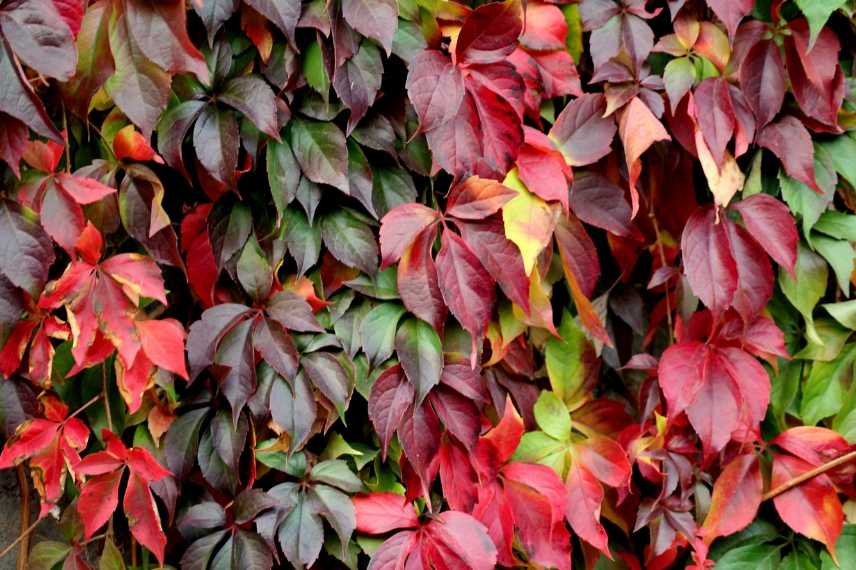
Virgin vine – Parthenocissus quinquefolia
- Discover our range of Virgin vines and our factsheet on Virgin vine: planting, pruning, care.
Discover other Climbers
View all →Available in 0 sizes
Available in 0 sizes
Available in 0 sizes
Available in 0 sizes
Available in 0 sizes
Available in 1 sizes
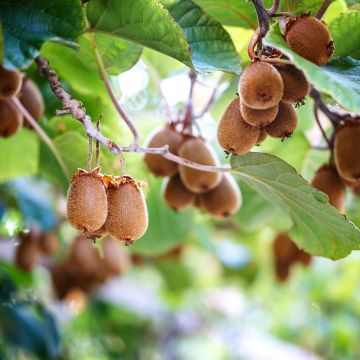
Available in 2 sizes
Available in 1 sizes
Available in 1 sizes
Climbing hydrangeas
Whether Hydrangeas or Schizophragmas, two closely related genus, climbing Hydrangeas are among the garden classics for shady areas. These lianas, with deciduous to evergreen foliage, cling to their support unaided thanks to non-destructive climbing roots. They offer, as well as decorative foliage, flowering that extends from spring to autumn, in white or pink umbels, particularly bright in dark spots.
Schizophragmas, some of which can display intense green foliage like the variety ‘corylifolium‘, or grey with a tin sheen in ‘Angel Wings‘, are particularly renowned for their spectacular flowering. Some can easily reach more than 15 metres, but they take several years to establish. Climbing Hydrangeas often remain more restrained, the most vigorous being ‘Miranda‘, whose variegated foliage reaches 6 metres.
Plant your climbing Hydrangeas in light, consistently moist soil, free of lime. Schizophragmas are a little more demanding and require more acidic soil. With varying hardiness, some climbing Hydrangeas suffer from -10°C, while others withstand -25°C without flinching.

Climbing hydrangea, hydrangea petiolaris
- Discover all our Climbing Hydrangeas, our sheet on Hydrangeas: planting, pruning and care as well as our sheet on Schizophragmas: planting, cultivation, care.
Read also
Shade Bush: Which Ones to Choose?Honeysuckle
Fragrant liana, Honeysuckle is one of the most popular climbing plants. Its foliage, often evergreen, bears trumpet-shaped flowers throughout summer in a range of colours. Treat yourself to the pink shades of the very floriferous ‘American Beauty‘ or to the orange tones of ‘Firecracker‘. Beyond the classics ‘Halliana‘ and ‘Hall’s Prolific‘, there is indeed a lovely diversity among honeysuckles, some even showing highly attractive variegation, such as ‘Mint Crisp‘, which blends green and yellow.
Climbing plants with voluble stems that entwine their support, Honeysuckles are lianas with woody climbing stems easy to grow, provided you plant them in deep, cool and well-drained soil. They then spread 2 to 6 metres and perfume summer evenings with their delicate scent. Of rapid growth and often hardy down to -15°C, they can be grown in many regions.
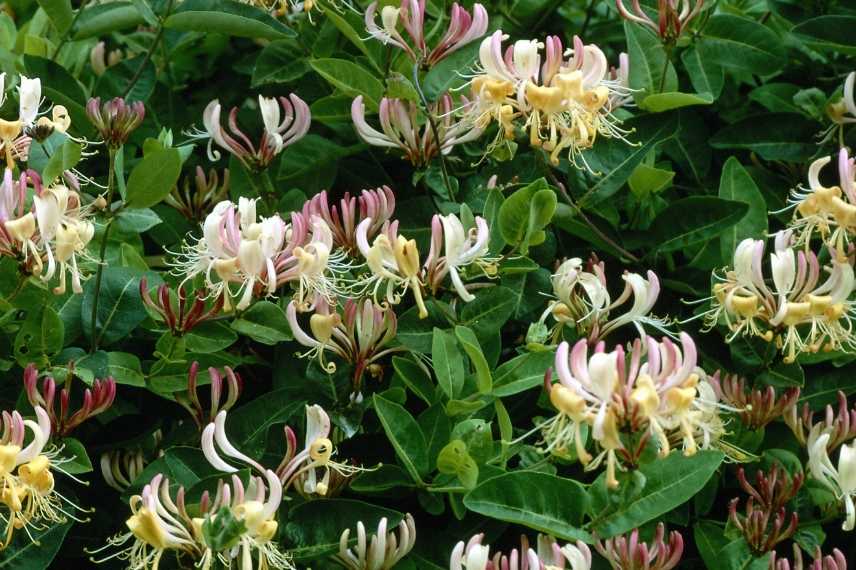
Honeysuckle, Lonicera caprifolium
- Browse our wide range of Honeysuckles and read our sheet on Honeysuckle: planting, pruning and maintenance.
Akebia
Also known as the “chocolate liana”, Akebia is an original, undemanding climbing plant that is easy to grow. Fast-growing (it can reach adult size in 3 years), it produces generous, architectural foliage, deciduous to semi-evergreen depending on winter severity. Green in spring, it turns purple in autumn and provides a backdrop to a generous spring flowering, in clusters of little bell-shaped blooms with a vanilla scent. Choose variety according to colour that appeals to you: purple with Akebia quinata, cream-white for ‘Cream Form‘ or pale mauve and silvery if you opt for ‘Silver Bells‘. In warm climates, edible bluish fruits may follow the flowering. A vigorous liana, Akebia can reach 10 metres in every direction and, although easier to manage than a wisteria, provide support of a matching size. Its voluble stems will twine around the support by themselves until they eventually hide it.
Akebia prefers light, fertile soils, moist but not waterlogged. It tolerates less favourable conditions and grows in any neutral to slightly acidic soil. Its shallow rooting and good hardiness (around -15 °C), make it suitable for all gardens.

Akebia quinata
- Discover all our Akebias in different colours, as well as the sheet on Akebia: planting, pruning and maintaining.
Holboellia
Little known, Holboellia is nevertheless a cousin of Akebia. Of rather rapid growth, it can easily reach 5 m in height. Its foliage, evergreen, is dark green and glossy. In spring, white or purplish flowering, depending on whether flowers are male or female, adorns plant. Discreet, its clusters of bell-shaped flowers diffuse a citrus scent and are followed by a few purplish fruits if summer is warm. Two most hardy and easiest-to-grow species are Hoelbellia coriacea (Blue Chinese vine) and Hoebellia latifolia (Goufla).
Plant this exuberant liana in humus-bearing, cool, well-drained soil in sheltered position, as its hardiness is fairly modest (-10°C). Train voluble stems against support.
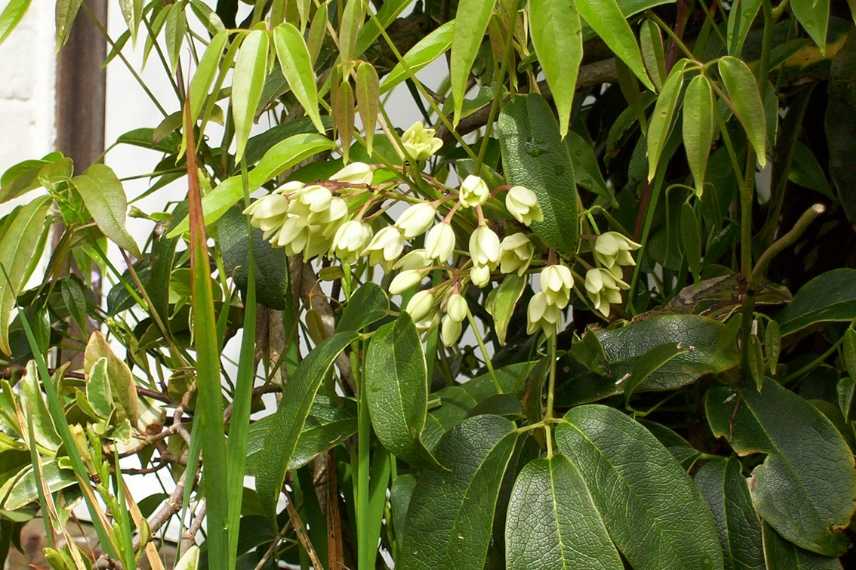
Holboellia coriacea – Blue Chinese vine
Berberidopsis
Rare shrubby climber, Berberidopsis or “coral plant”, is a liana of great elegance. Its evergreen foliage is highly ornamental. Heart-shaped and elongated, leaves display a beautifully glossy green. Their margins are slightly dentate. Flowering is not showy, but it occurs in mid-summer and can continue into early autumn depending on climate. Flowers, gathered in clusters of small rounded corollas that hang on long peduncles, are reminiscent of fuchsias. Their typical colour, coral red, stands out gracefully against dense foliage. With moderately fast growth, Berberidopsis is however not very hardy. While it can withstand temperatures around −12 °C in dry soil and for a short period, it may succumb at −5 °C in waterlogged soil. It is therefore a climber best reserved for regions with mild winters. In all cases, ensure good drainage at planting and provide humus-bearing, light, acidic soil. In good conditions, this liana can climb to 5 metres, thanks to its voluble stems and sparse climbing roots.
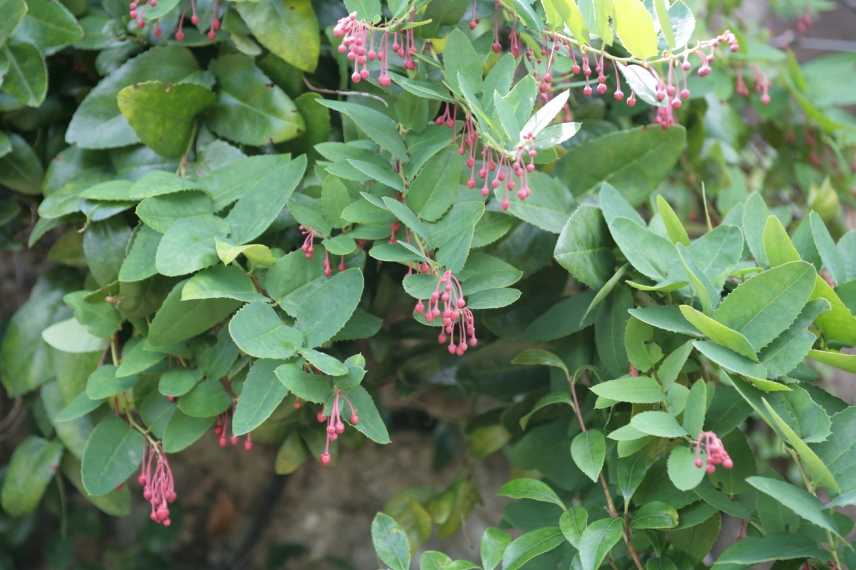
Berberidopsis corallina – Coral plant
Birthwort
Main attraction of Aristolochia durior lies in its foliage. Large, dense and luxuriant, it brings an exotic note to the garden. Leaves, deciduous, are heart-shaped and a deep, glossy green. Flowers, which open in summer, are tubular and combine green, yellow and brown. They are, however, small and hidden within the foliage. This rapidly growing, very disease-resistant climbing plant has average hardiness (-10°C). Its opulence and vigour (8 m in all directions) nevertheless make it ideal for forming a fine screen of foliage, attractive for much of the year. It suits all soils, provided they remain moist during growth period. Plant it against a support that its voluble stems can climb.
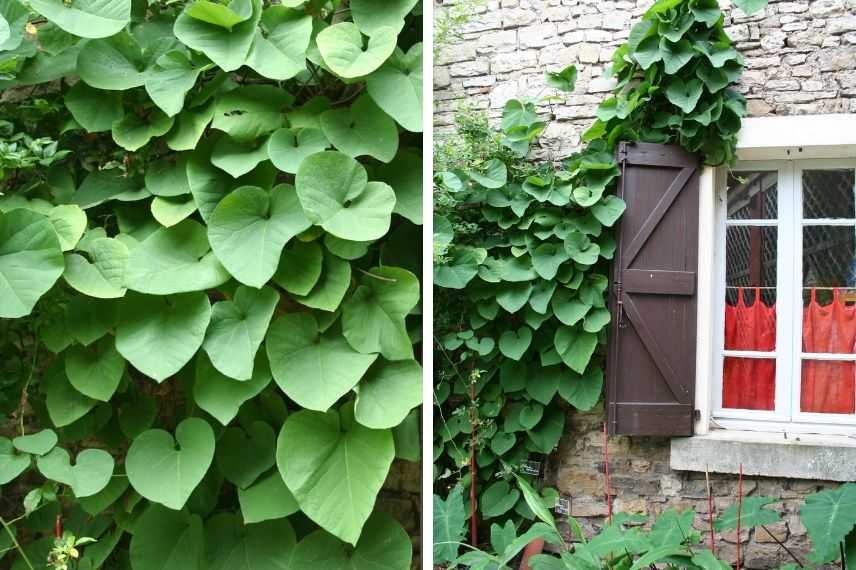
Aristolochia macrophylla (Durior)
Perennial nasturtiums
While annual nasturtiums are well known to gardeners, there are also perennial species which, once established, return each year. They then form beautiful climbing plants with bright and cheerful colours. This is the case of the Elegant nasturtium (Tropaeolum speciosum), a rhizomatous liana with rapid growth, climbing to about 3 metres. It has elegant foliage, deeply lobed, fresh green, which can be semi-evergreen in mild climate. Scarlet tubular flowers adorn the plant from summer until first frosts, before giving way to decorative fruits, small blue pearls set in a red calyx. Another original climber, the Chilean nasturtium is covered in bright yellow flowers veined with purple. Very vigorous, it easily reaches 3 to 4 m and can be somewhat invasive. Nasturtiums prefer cool but well-drained, rich, humus-bearing soils, yet can tolerate tougher conditions. Hardy to -10°C, they chiefly fear winter wet. They cling to supports using their petioles.
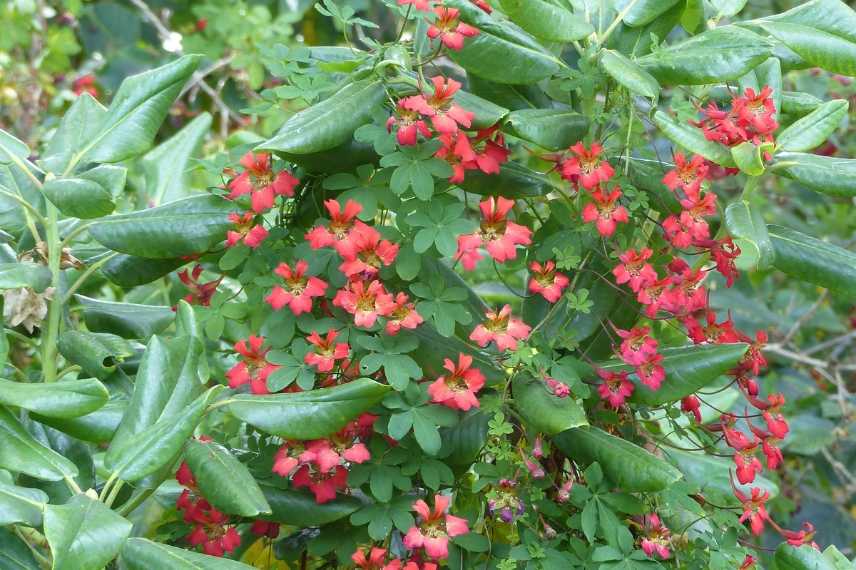
Tropaeolum speciosum
Japanese Kadsura
Superb Asian liana, Kadsura japonica adorns garden year-round thanks to its remarkable evergreen foliage. Glossy green, it is irregularly but generously edged with yellow and cream in Kadsura japonica ‘Fukurin’. Leaves, elongated in shape, are finely dentate and turn pink during bud burst period, as does entire foliage in response to cold. Flowers, slightly scented, small and sometimes inconspicuous, resemble those of magnolias. White with a red centre, they open in summer and, at end of season, give way to very decorative fruit. Each fruit, which stands out well against foliage, resembles an intensely red mulberry. With fairly rapid growth, Kadsura reaches 3 metres in height in any neutral or acidic, moist, rich and humus-bearing soil. Foliage may disappear below -5°C but stump survives lower temperatures, around -12°C. Easy to grow and non-invasive, this climbing plant remains decorative year-round in regions with mild winters.
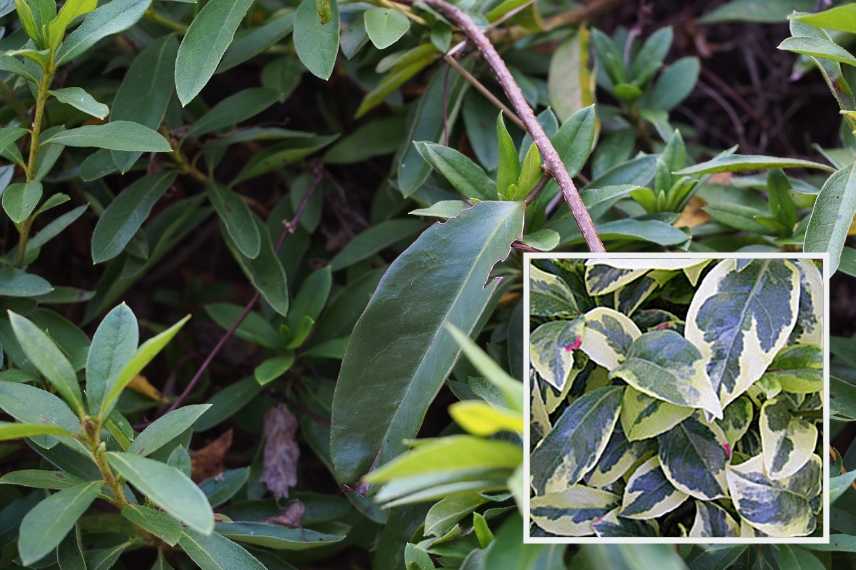
Kadsura japonica and foliage of variety ‘Fukurin’
- Subscribe!
- Contents
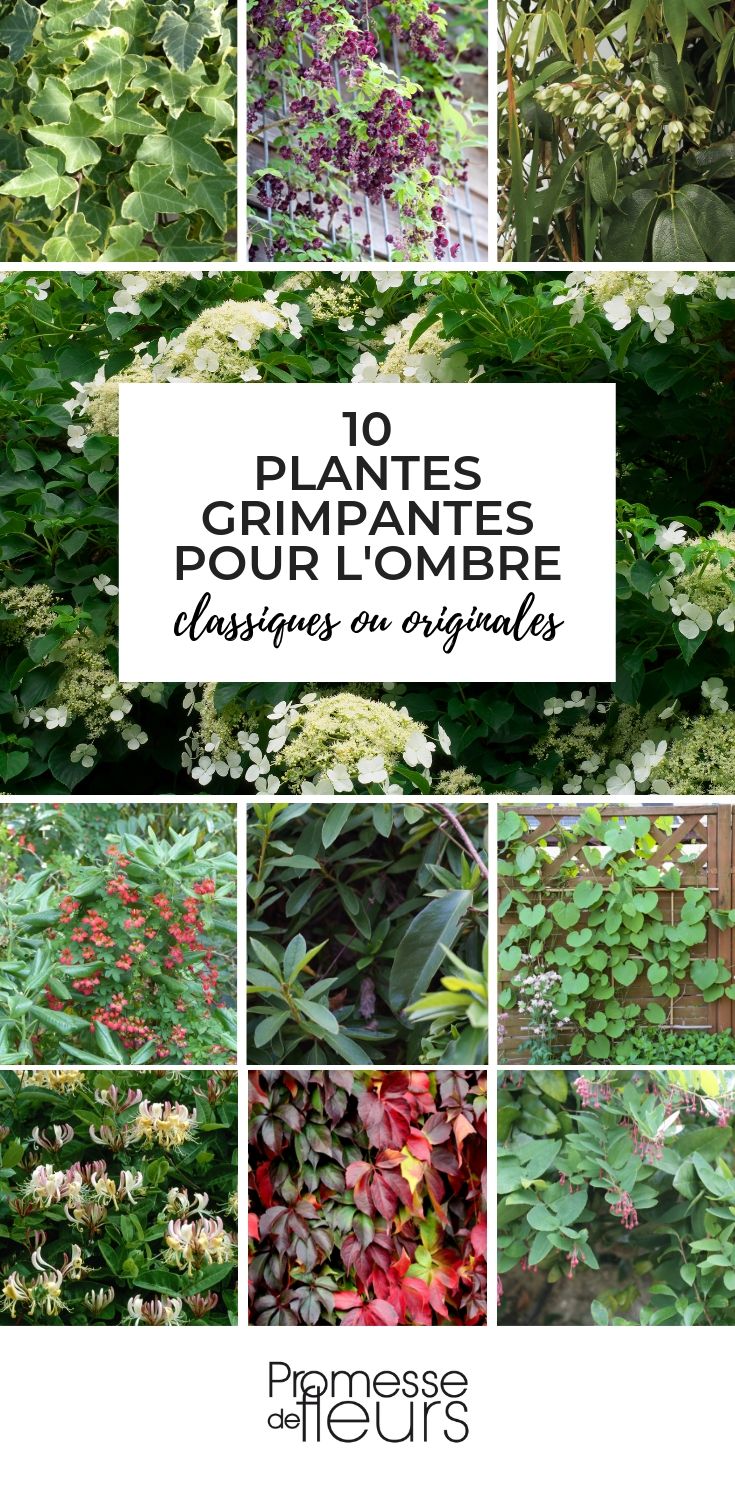































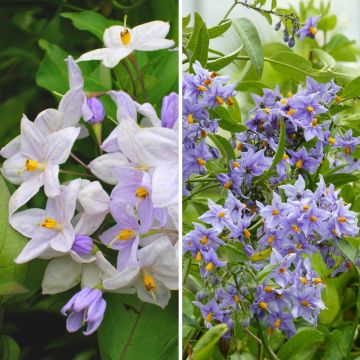
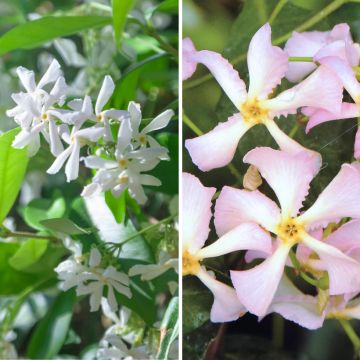
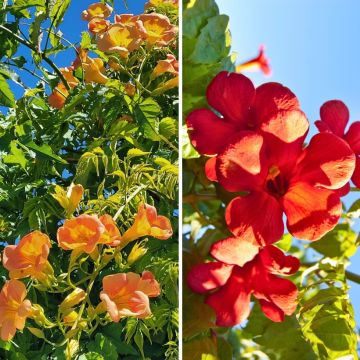
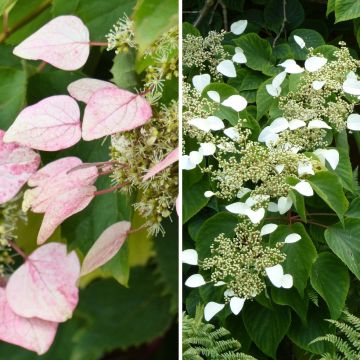
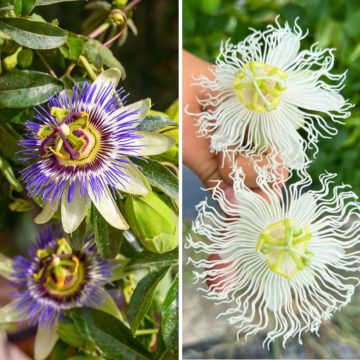

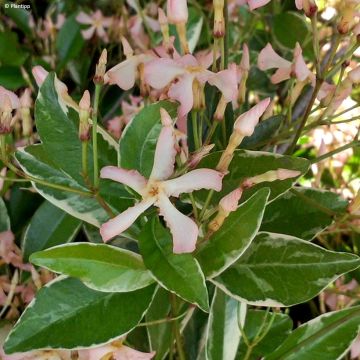

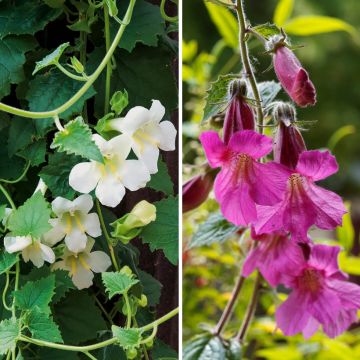
Comments